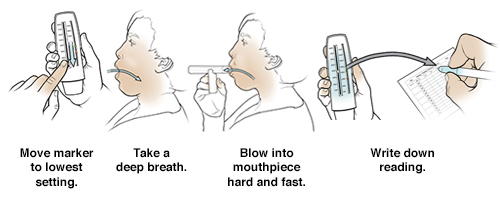Using a Peak Flow Meter
Using a Peak Flow Meter
A peak flow meter measures how fast you breathe out or push air out of your lungs. This tells you how well you are controlling your asthma. Check your peak flow as often as instructed to do so by your healthcare provider. For example, it may be once a day or only when you think your symptoms are getting worse.
How to use a peak flow meter
Step 1:
Move the marker to 0, or to the lowest number on the scale.
Stand. If you can’t stand, be sure to sit up straight. Make sure you’re in the same position each time you test.
Step 2:
Take as deep a breath as you can.
Put the mouthpiece in your mouth, between your teeth. Close your lips tightly around it. Be sure your tongue does not block the opening.
Blow into the mouthpiece once, as hard and as fast as you can.
Step 3:
Take the meter out of your mouth.
Look at the marker. It will have moved along the numbered scale. Write this number down.
Move the marker back to 0, or to the lowest number on the scale.
Repeat the test 2 more times.
Write down your readings each time and take the record with you when you see your healthcare provider.
Determining your personal best
Your personal best is your highest peak flow number during 2 weeks when you do not have symptoms. Your other peak flow results are compared with your personal best. This helps you and your provider know how you are doing on days when you have symptoms. This includes when you are using an asthma action plan as directed by your healthcare provider. To find your personal best:
Step 1: Check your peak flow twice a day for 2 weeks. Do this when you are not having any asthma symptoms.
Step 2: Write down your peak flow readings and your personal best.
Updated:
October 03, 2017
Reviewed By:
Brown, Kim, APRN,Little, Frederic, MD
